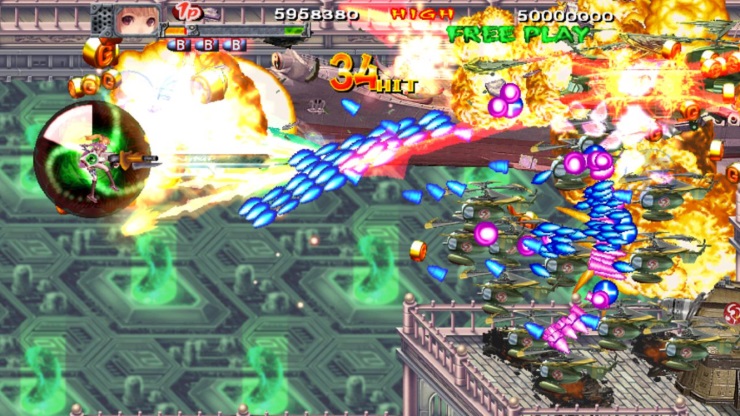As well as pretending to be Maradona down my local park – and by that I mean emulating his football skills and not shooting journalists whilst ripped to the tits on cocaine – my great love as a young man was playing videogames, something that has stayed with me through better or worse to this present day.
My taste in games is resolutely old-school; fighting games. Games where you don’t need to save your progress. Stuff you try to beat on one credit. Obscure, mysterious things from Japan. Titles that you could only ever play in the arcades. Don’t get it twisted – I love some of the wonderful games that are produced these days – I wouldn’t be enjoying what I do as much as I do without an appreciation of the medium – that seems to be progressing at an alarming rate technologically, pushing the boundaries of how immersed in a game you can become.
But if I was somehow captured and held at gunpoint, and forced to choose between sticking to the current generation of games and never being able to play my golden oldies again, I know what answer I would be giving to that poor, crazed gunman.
This is why I am once again submitting to the GodisaGeek Vault, throwing another ten games into your bemused gaming faces, some of which you may be familiar with, and some that I hope you will endeavour to make yourself familiar with. And this time around it is not two meatheads kicking each other’s heeds in, but the humble horizontally scrolling shoot ‘em up.
My first contact with such a game would probably have been Defender, Williams’ smooth as silk classic from 1980. Then I am pretty sure that a newsagent near me had Scramble, another early 80s relic from Konami that featured the vivid image of a blue “FUEL” tank that you needed to dispatch in order to stop your ship from running out of fuel. Yes, they had arcade cabs in the newsies when I were a chavvy. When the fairground came to Southampton Common there would be umpteen new games to try out – including Capcom’s Side Arms: Hyper Dyne which gave me my first real taste of weapons upgrades systems.
Soon I would have a decent enough computer at home to play shooters in the comfort of my bedroom – which meant arcade conversions galore such as Salamander, Gradius and MagMax alongside other British developed fare such as Jeff Minter’s loony Attack Of The Mutant Camels and Ocean’s sublime Wizball. Time went on, and I lived through the slew of rock-hard UK-developed Amiga shooters. In fact I still have nightmares thinking about how fist-bitingly tough the likes of Project X and beautifully designed insectoid caper Apidya really were. And then I progressed to the consoles, and all of the wonderful Japanese-y delights that came with them, more of which later in the core list.
Soooo – the premise is usually dead simple – a lone spacecraft against the baddies, left to right, with bosses and weapons and whatnot. But here I have picked out some proper corkers, a real mixed bag stuffed with variety that will have you hopefully fiending for some retro bullet mayhem.
10: Progear No Arashi (CAVE/Capcom, Capcom CPS-2, 2001)
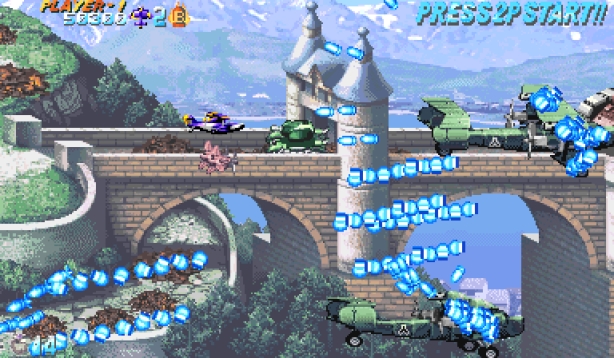
Heard of CAVE? Nah? Well first of all come out from whatever rock you have been living under and hear this – they are a Japanese games devco who helped make maniacal, bullet-hell style shoot ‘em ups into practically an art form. Up until 2001, they had only made vertically scrolling titles, including the utterly brilliant DonPachi and DoDonPachi, and had only released them in their homeland. But then they climbed into bed with Capcom to produce the magnificent Progear No Arashi on Capsule Computers’ CPS-2 arcade hardware, which received a limited run in the United States under the shortened Progear moniker.
Progear features a stunning Steampunk art style and retains some of the bullet hell mechanics from CAVE’s other titles, with extra points and multipliers accessed depending on the manner in which you destroy enemies and bullets, and the jewels you collect for destroying them. Only five stages long, Progear comes into its own as an exercise in survival and scoring maximisation, and getting through to the end of the final stage having lost only one of your allocated lives allows you to enter a second “loop” of levels, which features increased scores awarded for collecting jewels, and even more difficult enemies.
9: Gradius V (Konami/Treasure Sony PlayStation 2, 2003)
Everyone loves a bit of Gradius, right? You fly your classic and hilariously named Vic Viper spacecraft, shoot the waves of enemies – particularly the red ones which drop power-up capsules – and eventually end up surrounded by multiple-firing satellites or “Options” as you attempt to SHOOT THE CORE!
Well, Gradius V does all of that and more. With development of the game outsourced to hardcore gaming godheads Treasure, what you get here is Gradius on steroids, with bigger and more frequent bosses, a large selectable array of customisable weaponry, sublime graphics and level design and a superlative soundtrack.
Rightly lauded at its time of release, Gradius V is easy to get hold of and even has full 60hz support for PAL territory PS2 owners. As such you would be mental if you didn’t fancy a tilt at the evil Bacterian empire.
8: R-Type Delta (Irem, Sony PlayStation, 1998)
Many people will argue that the original R-Type should have been included in this list. And yes, it was a groundbreaking game that introduced more than one innovative feature to the genre – namely the Force, a fully controllable weapon device that can be placed at either end of your craft or fired off ahead of you to blast enemies remotely; and the stunning level that sees your ship circumnavigate an enormous enemy ship which you systematically destroy piece by piece.
But R-Type Delta, released exclusively for the Sony PlayStation in 1998, has all of this and more – introducing a selection of different selectable R-Type craft and weapons systems, the new Dose system which allows you to unleash a crazy super-weapon when the Force has absorbed enough energy from enemies and projectiles, and all in stunningly rendered 3D graphics.
Of course, just like its predecessors, R-Type Delta is bloody difficult. You only get a limited number of continues and the gameplay is a harsh lesson in memorising enemy patterns and the layouts of the twisting, turning, obstacle laden levels full of horrid biomechanical Bydo scum. But that is why you play an R-Type game, and why they are pretty much all ace.
7: Einhander (Square, Sony PlayStation, 1997)
Square may have been more famous for creating role playing games, and it is fair to say that when they ventured out of their comfort zone and tried something different, there were usually “mixed” results to say the least. I am looking at you, Ehrgeiz: God Bless The Ring. Amazingly, in 1997, at a time when there was little competition on the format, Square shocked us with an excellent side-scroller in the form of the pseudo-3D, Teutonic-sounding romp Einhander.
Meaning “one handed”, Einhander refers to the blinding weapon system available to your spacecraft, which has a mechanical arm used to grab weapons add-ons discarded by destroyed enemies and put them to your own use. There are a vast array of weapons to equip, including homing missiles and even giant light-saber-esque swords. You can alter the angle and direction of your fire as you aim to earn bumper score multipliers by shooting alien scum in their juicy core, to a thumping techno soundtrack. The enemies are wildly varied, with some huge bosses to contend with, most of which are comprised of numerous different sections that you need to destroy systematically.
Although this super title did not make it as far as Europe, it was released in the States, with the lucky Yanks in receipt of a slightly tweaked game with improved mechanical arm control. That said, it is readily available on the PlayStation Network for those gamers with a Japanese-region account, and we would sincerely recommend you snap it up.
6: Border Down (G.rev, SEGA NAOMI, SEGA Dreamcast, 2003)
As well as being a developer in their own right, Japanese firm G.rev, formed out of the ashes of the same Taito studio that produced seminal titles like 1991 classic side-scroller Metal Black and outstanding “lock-on” system vertical blaster Rayforce, have something of the “guns for hire” about them. They did some contract work on two of the most critically acclaimed shoot ‘em ups of all time in Gradius V and Ikaruga, before deciding to revisit some of the themes in Metal Black when crafting their own first tilt at the genre.
The result was Border Down, a slick looking confection that hit arcades and SEGA’s ill-fated Dreamcast in 2003. It featured a unique game system – instead of having a stock of lives when you begin playing, Border Down allows you to select from three different levels of difficulty, or “borders” – varying from green to red. The green border is the easiest option in terms of the enemies you will encounter and their rate of fire – however the stages are much longer. Red, on the other hand, will have a much shorter stage but a frenetic difficulty level. The twist is, each time your ship is destroyed, you are re-deployed in the next border down, hence the title. If you get greased whilst playing the red border, it is game over, man.
Even with two weapons types depending on whether you tap or hold down the buttons, and a handy smart bomb attack, Border Down is utterly nails. Unless you have masochistic tendencies, you will attempt to avoid dropping down a border and try to master the easier green stages in order to progress. But masochism is what makes score-based shooters such fun, and naturally you are rewarded for becoming a master of the loony red levels.
Given the fact that the DC had long been on the bones of its arse whilst this was being developed, it was released after the official discontinuation of the much-loved platform. It was only given a limited print run, so copies these days change hands for some serious scrilla. Don’t expect to have much change out of £150 for this Japanese-only treat.
5: Blazing Star (Yumekobo, Neo Geo, 1998)
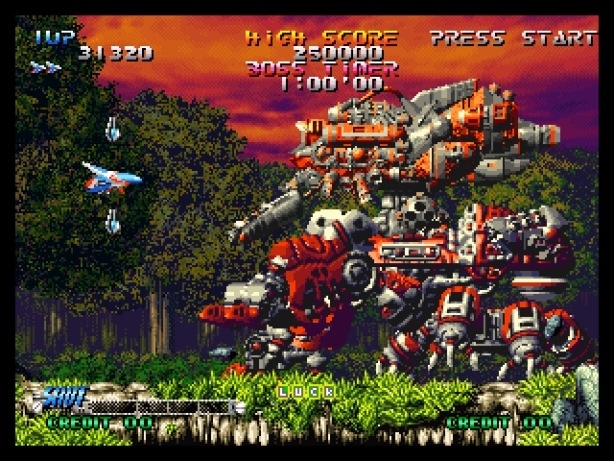
As well as being a fighting fan’s gaming platform nirvana, the Neo Geo was also home to some A-grade shooters. The notoriously difficult isometric Viewpoint and R-Type inspired Last Resort are both completely beezer, but my personal fave and one I hammered near-to death when I owned an MVS arcade cabinet was the beauteous Blazing Star.
The sequel to earlier, similarly good Neo release Pulstar, developer Yumekobo returned to the table with a sophomore blaster that combined rendered 3D sprites, some terrific use of colour to paint the backdrops and scenery, some huge weapon power ups and even sneaks in some anime cutscenes. The icing on the cake is the fact that Blazing Star arguably created an internet meme which has become part of everyday use for nerds, internet bods and texters to this day; one of the brain-meltingly funny Engrish translations announcing your demise reads:
“You fail it! Your skill is not enough; see you next time, bye-bye!”
For a generation of gamers still pissing themselves laughing at “GAME OVER, YEEEAH!” this was a landmark moment in unintentional comedy from our Japanese cousins.
4: Silkworm (Tecmo, Arcade/Various, 1988)

First encountered by yours truly at a swimming baths on the outskirts of Southampton, Silkworm was an arcade shooter with a co-op twist – two buddies could play together, wasting the enemy scum in glorious tandem – on both land and in the air.
Yessir, Tecmo’s military-themed 1988 classic allows control of either a helicopter or a jeep. The chopper can only fire forwards with guns and rockets, whilst the jeep has a rotating gun that can fire in all directions and is able to jump over certain obstacles. Working together in harmony, the jeep and the helicopter can each cover the shortcomings of the other, as you take on the increasingly harder levels.
You could, of course, experience Silkworm on your own and choose between whether you pilot the helicopter or the jeep, giving you several different ways to experience the excellently balanced action, which still plays like a dream to this day.
The Sales Curve produced some stunning conversions of Silkworm for home gamers, with particular mention to the Amiga and Commodore 64 ports, which spent many hours in my disc drive and cassette deck, respectively.
3: Area 88/U.N. Squadron (Capcom, Arcade, 1988)
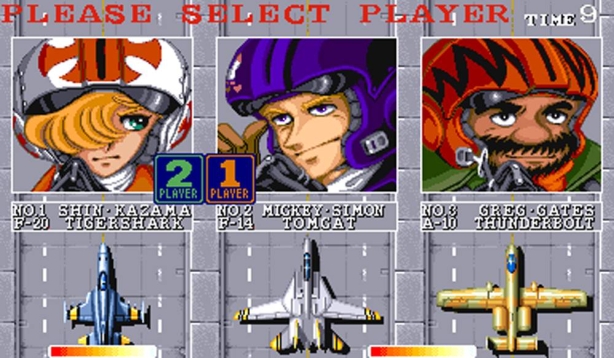
Capcom hadn’t really had a pop at producing a side scrolling shooter before their CPS arcade hardware was released, Side Arms aside. But when they did they certainly knocked it out of the park, firstly with the excellent Forgotten Worlds, and then with the shit-hot Area 88 which surfaced in arcades in 1989.
Based upon a long-running Manga series that followed the fortunes of a group of charismatic mercenary air force pilots, with semi-realistic portrayals of aerial combat and military planes, Area 88 gives you the choice between three of the series’ protagonists – Shin, Kim and Mickey – each with their own abilities and strengths, and of course their own plane.
Like Forgotten Worlds, Area 88 also features a shop which allows you to purchase weapons upgrades between levels. Money to spend on your arsenal is awarded for shooting down enemies over the course of a level, and you are also rewarded for not using your powerful smart bombs or missile attacks and receive additional funds accordingly.
With an excellent two player mode, a huge variety of terrain and corresponding enemy vehicle types, Area 88 remains a joy to play. It received a western release – albeit clunkily re-named “U.N. Squadron” – something of an insult to the awesome television show which ran from 1979 to 1986. There were home ports too – again, the Amiga being a standout – and a Super Nintendo version which has some rearranged stages, bonus levels, different weapons to buy and allows you to purchase and select different planes. It is well worth a look.
2: Sengoku Blade: Sengoku Ace Episode II (Psikyo, Arcade, 1996)
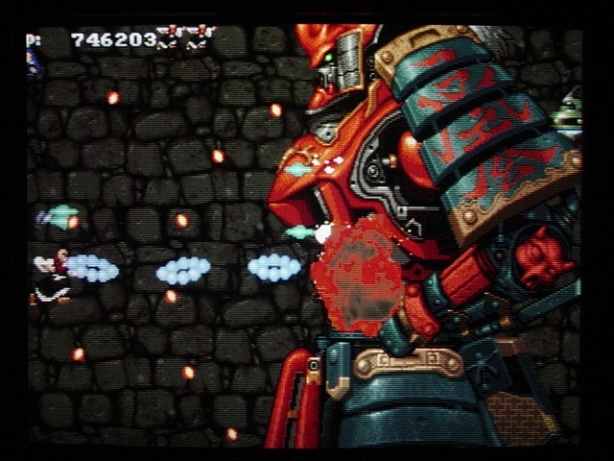
Like CAVE, Psikyo are a bit famous for churning out excellent shooting games, in particular their popular Strikers 1945 vert scroller. In 1993 they served up the entertaining Sengoku Ace – another vertical scroller, taking its characters and imagery from Japanese history and featuring mystical avatars who fly through the air of their own accord as opposed to piloting a spacecraft or other such contraption.
Still with us? Well, Sengoku Blade is the 1996 sequel, and turns things around to a horizontal plane, whilst retaining the same setting and some of the characters. The branching, enemy packed levels were stunning examples of 2D graphical wizardry for the time, and indeed a return to the smooth, multi-layered parallax scrolling and well-designed sprites still impresses.
There are six characters to choose from, each with their own distinct style and personality, and of course weapon types. You have a steely-eyed Buddhist monk dude, a tricked-out Samurai robot, and of course a young girl with massive tits. Each of the floating badasses at your disposal have a helpful familiar that will act like an “option” and attack enemies when you hold down the button. Collecting power-ups and maxing out your character can result in some pretty impressive firepower, as you aim to reach the end and take down the Lord of Evil.
What attracted me to Sengoku Blade is the unusual setting, the well judged difficulty curve and wide selection of characters. If you are able I would thoroughly recommend picking up the Sega Saturn version, which comes bundled with a wonderful disc full of artwork, including some fan art that was included as part of a contest Psikyo ran.
1: Sexy Parodius (Konami, Arcade, 1996)
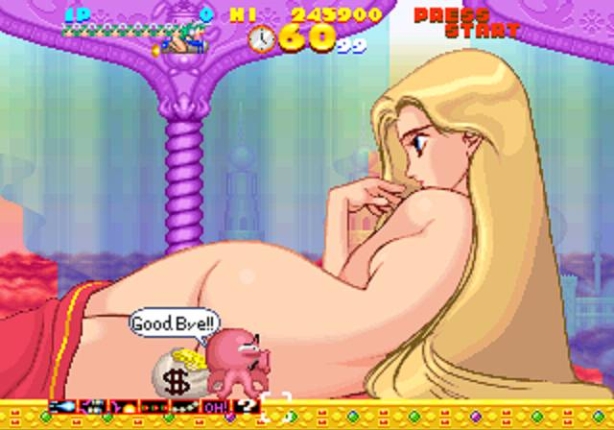
Gradius is such an iconic series that it received not one but two series of parody titles poking fun/paying homage. Parodius was first up, running from 1988 and still featuring in Japanses pachinko machines to this day. More recently Konami girl-ified the series to create the well received Otomedius jaunts. Such was the quality of these two franchise piss-takes, they have gone on to become just as popular as Vic Viper’s original assaults on the dastardly Dr Venom, receiving ports to the likes of the Xbox 360 and PlayStation Portable.
My favourite from this comedy subgenre would certainly be the bat-shit mental Sexy Parodius. Arriving before stunned Japanese arcade-goers in 1996, it follows the usual pattern of transporting Konami/Gradius staples such as Vic Viper, Pentarou and, in this case even a controllable, single, Gradius “option” (!) into a wacky approximation of a hori shooting game, but this time throws in a shed-load of sexual innuendo, half naked women, dodgy tentacles and other such risqué material.
But it is not all about titillation – Sexy Parodius adds a genius gameplay mechanic that requires fulfilment of certain conditions on each level – such as collecting a specified number of coins, shooting a certain number of enemies – affecting which level you enter next, depending on whether or not you completed your designated mission.
As you can imagine, all manner of ker-azy shenanigans are thrown your way over the course of the game, and you are never quite sure what is around the next corner. With the Gradius weapons barrage also given suitably insane twists, Sexy Parodius is an absolute winner and easily available as part of a stunning Parodius collection for PlayStation Portable.


